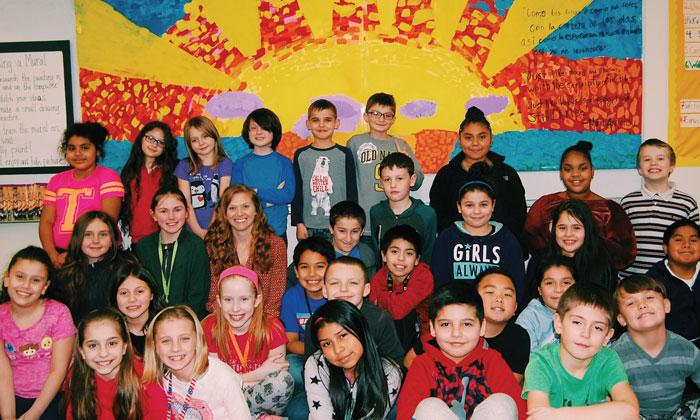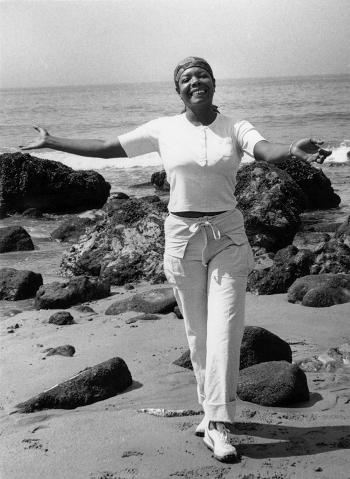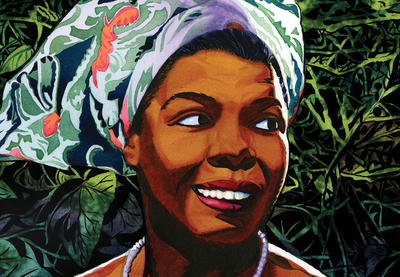Who Is Maya Angelou to You?
Ask five people who Maya Angelou was, and you’re apt to get five different answers. Over the 86 years of her life, she pushed the world toward a more equitable future through her work as a poet, civil rights activist, essayist, director, editor, playwright, dancer, singer, actor, composer and historian.
In April of 2018, Angelou would have celebrated her 90th birthday. What better time to introduce your students to a woman who overcame tremendous obstacles to become a leader in the fight against injustice and inequity?

The Power of Poetry
When Amanda Jensen saw her third- and fourth-graders struggling to process feelings of fear and uncertainty during the 2016 election, she decided to get them thinking and talking about power and agency. Armed with a shelf full of books about diverse leaders, Jensen set out to teach her students about people who have made a difference in times of adversity.
In the process, she found that kids were particularly drawn to one person—Maya Angelou. “There’s something about that poem, ‘Still I Rise,’” says Jensen. “Once you find its meaning and make connections with it, it’s a poem that stays with you forever.”
Knowing that her class had engaged well with art projects in the past, Jensen decided to use art to help students connect with the message of empowerment in Angelou’s poem. She asked students to read a portion of the poem, explain what they thought the passage meant and how it made them feel, and then illustrate their thoughts.
The poem makes me feel stronger than I am right now. It also makes me feel that I can do more than I can right now.
— Elementary Student
Jensen says the reactions to Angelou’s poem were inspiring. “I think what she is trying to say is that nothing can stop her. And whatever happens, she will keep on going and going,” wrote one student. “This makes me think she’s saying she won’t give up. It makes me feel confident. She makes me feel strong,” wrote another.
The project became collaborative as students took the concepts from their personal illustrations and added them to a large class mural featuring Angelou’s poetry in both English and Spanish. By the time everyone had contributed to the painting, it was almost too heavy to hang, says Jensen.
The mural still hangs in the hallway outside Jensen’s classroom where it can continue to help students to see themselves as “active members working toward an inclusive, empowering, affirming and safe world for all.”
Still I Rise
Maya Angelou
You may write me down in history
With your bitter‚ twisted lies‚
You may trod me in the very dirt
But still‚ like dust‚ I’ll rise.
Does my sassiness upset you?
Why are you beset with gloom?
’Cause I walk like I’ve got oil wells
Pumping in my living room.
Just like moons and like suns‚
With the certainty of tides‚
Just like hopes springing high‚
Still I’ll rise.
Did you want to see me broken?
Bowed head and lowered eyes?
Shoulders falling down like teardrops‚
Weakened by my soulful cries?
Does my haughtiness offend you?
Don’t you take it awful hard
’Cause I laugh like I’ve got gold mines
Diggin’ in my own back yard.
You may shoot me with your words‚
You may cut me with your eyes‚
You may kill me with your hatefulness,
But still‚ like air‚ I’ll rise.
Does my sexiness upset you?
Does it come as a surprise
That I dance like I’ve got diamonds
At the meeting of my thighs?
Out of the huts of history’s shame
I rise
Up from a past that’s rooted in pain
I rise
I’m a black ocean‚ leaping and wide‚
Welling and swelling I bear in the tide.
Leaving behind nights of terror and fear
I rise
Into a daybreak that’s wondrously clear
I rise
Bringing the gifts that my ancestors gave‚
I am the dream and the hope of the slave.
I rise
I rise
I rise.
Want to create a custom Learning Plan based on one of Maya Angelou’s poems? Search her name in the Perspectives text library.
Q&A A GRANDSON’S PERSPECTIVE
Colin Johnson, Angelou’s grandson, was at his grandmother’s side at just about every event she attended during the last 25 years of her life, he says. She—and her friends—called him “The Grand.”
In celebration of what would have been Angelou’s 90th birthday, Johnson spoke to Teaching Tolerance about who Angelou was when she was outside of the public eye.
What would you like people to know about your grandmother that can’t be gleaned from a biography citing her work and awards?

There are plenty of people who have gotten the individual awards she has gotten. … But the difference for me is the way in which my grandmother did it and her style and spirit while doing it. She had an amazing laugh and a singing voice that was full of life. And after the tough life she lived, it’s just amazing the spirit that she kept.
We talk about my grandmother finding her voice twice: first after her mutism and then, once she grew up and had the number of experiences that she had, the voice that rose in her that would never be quieted. She felt like injustice and inequality were just not right for this world. … And she believed even before this phrase was popular that art is action, that you can move mountains, and you can move people, through your art form and giving truth.
Angelou is well known as both a poet and activist, but perhaps less well known as an educator. How did she turn art into action in the classroom?
What she said is that she thought for a long time that she was a writer that could teach, and eventually she realized that she was a teacher who could write. … My grandmother believed that books were freedom from ignorance and that they could transport you anywhere. And in that very moment, when you transfer someone to West Africa or Egypt or Rome or London, you are taking action in that kid’s life and exposing them to something and somebody else’s ideas and the beauty that comes from everywhere and everybody’s writing.
What would you say to students to help them realize the world your grandmother worked to create?
I would say that if you live with an open heart and you trust your gut and you love hard, you’re probably going to live an amazing life. And the only problems in life really come when you become calloused and you start to be jaded about what the opportunities in this world are and that people are innately great. Period. Everybody is innately great. Things might happen to them and make them worse people, bad people. … But in the heart of everybody is a really great person and everybody wants about the same thing you do. They want to eat, raise their kids, be successful, laugh a little bit, love a little bit. That’s it.
Pettway is a freelance writer and poet who lives and writes near Seattle, Washington.
THE LIFE OF A LEGEND
1928 Maya Angelou is born Marguerite Annie Johnson Angelou in St. Louis, Missouri.
1935 Loses her ability to speak after being sexually assaulted by her mother’s boyfriend, who is subsequently killed.
1940 Regains her voice with the help of mentor Bertha Flowers.
1945 Graduates from George Washington High School in San Francisco and gives birth to a son; becomes the first black female street car conductor in the city.
1954-1955 Tours the country as a cast member in the musical Porgy and Bess.
1959 Becomes the northern coordinator for the Southern Christian Leadership Conference (SCLC).
1961-1962 Becomes associate editor of The Arab Observer in Cairo, Egypt.
1964 Helps found the Organization of Afro-American Unity (OAAU).
1964-1966 Moves to Accra, Ghana, and becomes feature editor for African Review.
1969 Publishes her memoir I know Why the Caged Bird Sings.
1972 Becomes the first African-American woman to have a screenplay produced (Georgia, Georgia); Just Give Me a Cool Drink of Water ‘fore I Diiie is nominated for a Pulitzer Prize.
1973 Receives Tony Award nomination for Look Away.
1974 Returns to the United States.
1977 Is nominated for an Emmy Award after working on the TV miniseries Roots.
1982 Receives a lifetime appointment as Reynolds Professor of American Studies at Wake Forest University.
1993 Reads “On the Pulse of the Morning” at Bill Clinton’s inauguration.
1998 Directs Down in the Delta.
2000 Receives a National Medal of Arts.
2005 Receives NAACP Image Award for Hallelujah! The Welcome Table.
2009 Receives NAACP Image Award for Letter to My Daughter.
2010 Receives Presidential Medal of Freedom.
2014 Maya Angelou passes away at the age of 86.

